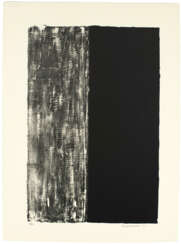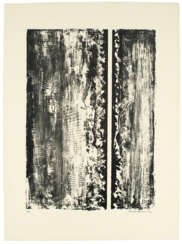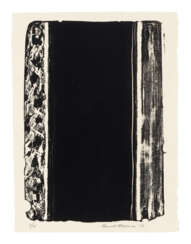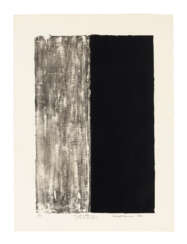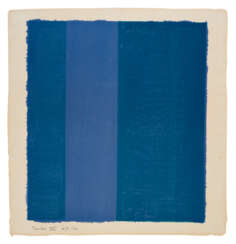Barnett Newman (1905 - 1970) — Auction price
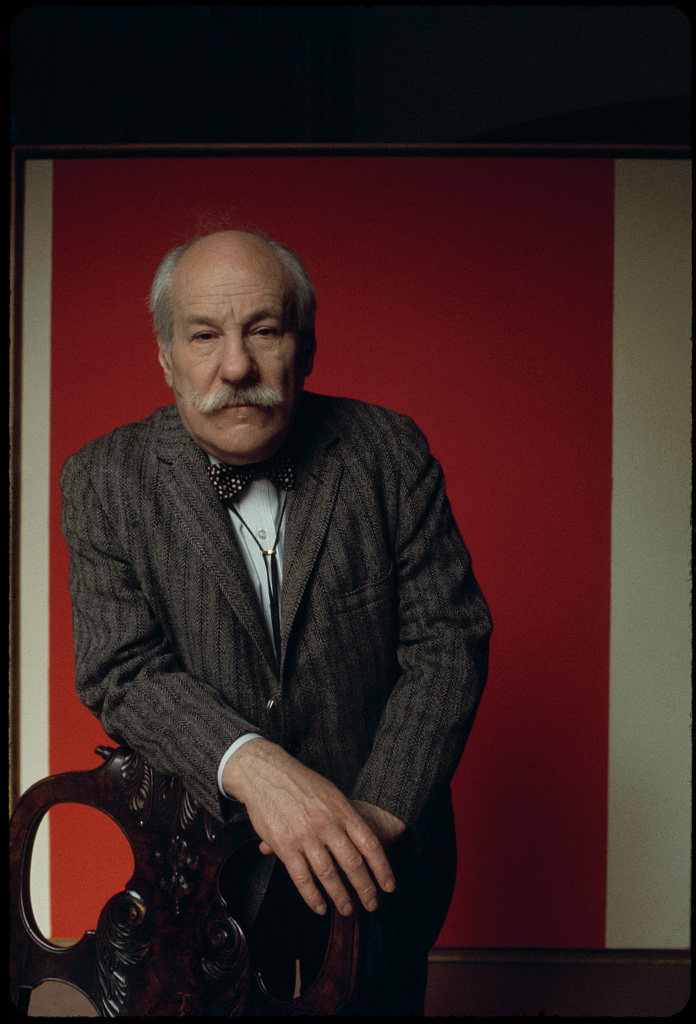
Barnett Newman was an American artist, recognized as a pivotal figure in the Abstract Expressionism movement. His innovative approach to painting, characterized by large fields of color and the distinctive use of vertical lines or "zips," marked a radical departure from the figurative norms of his time. Newman's work is celebrated for its ability to evoke profound emotional responses and invite philosophical contemplation, bridging the gap between the visual and the visceral.
Newman's artistic journey was one of constant evolution and self-discovery. After a period of experimentation and a brief hiatus from painting, he developed his signature style in the late 1940s. His creation of the "zip" became his trademark, a bold vertical line that dissected his canvases, challenging traditional perceptions of space and form. This innovation not only distinguished his work but also contributed significantly to the narrative of modern art. Among his notable works, "Onement I" marked the inception of this new direction, embodying the essence of his artistic philosophy. Newman's pieces, including the monumental "Vir heroicus sublimis" and the introspective "Stations of the Cross" series, are housed in prestigious institutions worldwide, attesting to his enduring influence on contemporary art.
Despite initial resistance and critique, Newman's oeuvre gradually garnered acclaim, with his contributions being integral to the discourse on abstraction and the sublime. His philosophical essays, particularly "The Sublime Is Now," articulate his vision of art's potential to transcend beauty and engage with existential themes. In his later years, Newman expanded his exploration into sculpture, further solidifying his legacy as a multifaceted pioneer of post-war American art.
For collectors and art and antiques experts, Newman's work represents not just an investment in art but an engagement with a transformative period in art history. His pieces are not merely visual spectacles but are imbued with depth and meaning, reflecting Newman's belief in art's capacity to communicate and connect on a profound level.
To stay informed about new sales, auctions, and exhibitions featuring Barnett Newman's work, we invite you to sign up for updates. This subscription ensures you are promptly notified of opportunities to acquire pieces by this influential artist, enriching your collection with works that embody the spirit of Abstract Expressionism.


Barnett Newman was an American artist, recognized as a pivotal figure in the Abstract Expressionism movement. His innovative approach to painting, characterized by large fields of color and the distinctive use of vertical lines or "zips," marked a radical departure from the figurative norms of his time. Newman's work is celebrated for its ability to evoke profound emotional responses and invite philosophical contemplation, bridging the gap between the visual and the visceral.
Newman's artistic journey was one of constant evolution and self-discovery. After a period of experimentation and a brief hiatus from painting, he developed his signature style in the late 1940s. His creation of the "zip" became his trademark, a bold vertical line that dissected his canvases, challenging traditional perceptions of space and form. This innovation not only distinguished his work but also contributed significantly to the narrative of modern art. Among his notable works, "Onement I" marked the inception of this new direction, embodying the essence of his artistic philosophy. Newman's pieces, including the monumental "Vir heroicus sublimis" and the introspective "Stations of the Cross" series, are housed in prestigious institutions worldwide, attesting to his enduring influence on contemporary art.
Despite initial resistance and critique, Newman's oeuvre gradually garnered acclaim, with his contributions being integral to the discourse on abstraction and the sublime. His philosophical essays, particularly "The Sublime Is Now," articulate his vision of art's potential to transcend beauty and engage with existential themes. In his later years, Newman expanded his exploration into sculpture, further solidifying his legacy as a multifaceted pioneer of post-war American art.
For collectors and art and antiques experts, Newman's work represents not just an investment in art but an engagement with a transformative period in art history. His pieces are not merely visual spectacles but are imbued with depth and meaning, reflecting Newman's belief in art's capacity to communicate and connect on a profound level.
To stay informed about new sales, auctions, and exhibitions featuring Barnett Newman's work, we invite you to sign up for updates. This subscription ensures you are promptly notified of opportunities to acquire pieces by this influential artist, enriching your collection with works that embody the spirit of Abstract Expressionism.


Barnett Newman was an American artist, recognized as a pivotal figure in the Abstract Expressionism movement. His innovative approach to painting, characterized by large fields of color and the distinctive use of vertical lines or "zips," marked a radical departure from the figurative norms of his time. Newman's work is celebrated for its ability to evoke profound emotional responses and invite philosophical contemplation, bridging the gap between the visual and the visceral.
Newman's artistic journey was one of constant evolution and self-discovery. After a period of experimentation and a brief hiatus from painting, he developed his signature style in the late 1940s. His creation of the "zip" became his trademark, a bold vertical line that dissected his canvases, challenging traditional perceptions of space and form. This innovation not only distinguished his work but also contributed significantly to the narrative of modern art. Among his notable works, "Onement I" marked the inception of this new direction, embodying the essence of his artistic philosophy. Newman's pieces, including the monumental "Vir heroicus sublimis" and the introspective "Stations of the Cross" series, are housed in prestigious institutions worldwide, attesting to his enduring influence on contemporary art.
Despite initial resistance and critique, Newman's oeuvre gradually garnered acclaim, with his contributions being integral to the discourse on abstraction and the sublime. His philosophical essays, particularly "The Sublime Is Now," articulate his vision of art's potential to transcend beauty and engage with existential themes. In his later years, Newman expanded his exploration into sculpture, further solidifying his legacy as a multifaceted pioneer of post-war American art.
For collectors and art and antiques experts, Newman's work represents not just an investment in art but an engagement with a transformative period in art history. His pieces are not merely visual spectacles but are imbued with depth and meaning, reflecting Newman's belief in art's capacity to communicate and connect on a profound level.
To stay informed about new sales, auctions, and exhibitions featuring Barnett Newman's work, we invite you to sign up for updates. This subscription ensures you are promptly notified of opportunities to acquire pieces by this influential artist, enriching your collection with works that embody the spirit of Abstract Expressionism.


Barnett Newman was an American artist, recognized as a pivotal figure in the Abstract Expressionism movement. His innovative approach to painting, characterized by large fields of color and the distinctive use of vertical lines or "zips," marked a radical departure from the figurative norms of his time. Newman's work is celebrated for its ability to evoke profound emotional responses and invite philosophical contemplation, bridging the gap between the visual and the visceral.
Newman's artistic journey was one of constant evolution and self-discovery. After a period of experimentation and a brief hiatus from painting, he developed his signature style in the late 1940s. His creation of the "zip" became his trademark, a bold vertical line that dissected his canvases, challenging traditional perceptions of space and form. This innovation not only distinguished his work but also contributed significantly to the narrative of modern art. Among his notable works, "Onement I" marked the inception of this new direction, embodying the essence of his artistic philosophy. Newman's pieces, including the monumental "Vir heroicus sublimis" and the introspective "Stations of the Cross" series, are housed in prestigious institutions worldwide, attesting to his enduring influence on contemporary art.
Despite initial resistance and critique, Newman's oeuvre gradually garnered acclaim, with his contributions being integral to the discourse on abstraction and the sublime. His philosophical essays, particularly "The Sublime Is Now," articulate his vision of art's potential to transcend beauty and engage with existential themes. In his later years, Newman expanded his exploration into sculpture, further solidifying his legacy as a multifaceted pioneer of post-war American art.
For collectors and art and antiques experts, Newman's work represents not just an investment in art but an engagement with a transformative period in art history. His pieces are not merely visual spectacles but are imbued with depth and meaning, reflecting Newman's belief in art's capacity to communicate and connect on a profound level.
To stay informed about new sales, auctions, and exhibitions featuring Barnett Newman's work, we invite you to sign up for updates. This subscription ensures you are promptly notified of opportunities to acquire pieces by this influential artist, enriching your collection with works that embody the spirit of Abstract Expressionism.


Barnett Newman was an American artist, recognized as a pivotal figure in the Abstract Expressionism movement. His innovative approach to painting, characterized by large fields of color and the distinctive use of vertical lines or "zips," marked a radical departure from the figurative norms of his time. Newman's work is celebrated for its ability to evoke profound emotional responses and invite philosophical contemplation, bridging the gap between the visual and the visceral.
Newman's artistic journey was one of constant evolution and self-discovery. After a period of experimentation and a brief hiatus from painting, he developed his signature style in the late 1940s. His creation of the "zip" became his trademark, a bold vertical line that dissected his canvases, challenging traditional perceptions of space and form. This innovation not only distinguished his work but also contributed significantly to the narrative of modern art. Among his notable works, "Onement I" marked the inception of this new direction, embodying the essence of his artistic philosophy. Newman's pieces, including the monumental "Vir heroicus sublimis" and the introspective "Stations of the Cross" series, are housed in prestigious institutions worldwide, attesting to his enduring influence on contemporary art.
Despite initial resistance and critique, Newman's oeuvre gradually garnered acclaim, with his contributions being integral to the discourse on abstraction and the sublime. His philosophical essays, particularly "The Sublime Is Now," articulate his vision of art's potential to transcend beauty and engage with existential themes. In his later years, Newman expanded his exploration into sculpture, further solidifying his legacy as a multifaceted pioneer of post-war American art.
For collectors and art and antiques experts, Newman's work represents not just an investment in art but an engagement with a transformative period in art history. His pieces are not merely visual spectacles but are imbued with depth and meaning, reflecting Newman's belief in art's capacity to communicate and connect on a profound level.
To stay informed about new sales, auctions, and exhibitions featuring Barnett Newman's work, we invite you to sign up for updates. This subscription ensures you are promptly notified of opportunities to acquire pieces by this influential artist, enriching your collection with works that embody the spirit of Abstract Expressionism.
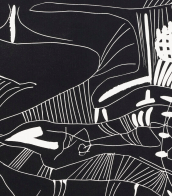

Barnett Newman was an American artist, recognized as a pivotal figure in the Abstract Expressionism movement. His innovative approach to painting, characterized by large fields of color and the distinctive use of vertical lines or "zips," marked a radical departure from the figurative norms of his time. Newman's work is celebrated for its ability to evoke profound emotional responses and invite philosophical contemplation, bridging the gap between the visual and the visceral.
Newman's artistic journey was one of constant evolution and self-discovery. After a period of experimentation and a brief hiatus from painting, he developed his signature style in the late 1940s. His creation of the "zip" became his trademark, a bold vertical line that dissected his canvases, challenging traditional perceptions of space and form. This innovation not only distinguished his work but also contributed significantly to the narrative of modern art. Among his notable works, "Onement I" marked the inception of this new direction, embodying the essence of his artistic philosophy. Newman's pieces, including the monumental "Vir heroicus sublimis" and the introspective "Stations of the Cross" series, are housed in prestigious institutions worldwide, attesting to his enduring influence on contemporary art.
Despite initial resistance and critique, Newman's oeuvre gradually garnered acclaim, with his contributions being integral to the discourse on abstraction and the sublime. His philosophical essays, particularly "The Sublime Is Now," articulate his vision of art's potential to transcend beauty and engage with existential themes. In his later years, Newman expanded his exploration into sculpture, further solidifying his legacy as a multifaceted pioneer of post-war American art.
For collectors and art and antiques experts, Newman's work represents not just an investment in art but an engagement with a transformative period in art history. His pieces are not merely visual spectacles but are imbued with depth and meaning, reflecting Newman's belief in art's capacity to communicate and connect on a profound level.
To stay informed about new sales, auctions, and exhibitions featuring Barnett Newman's work, we invite you to sign up for updates. This subscription ensures you are promptly notified of opportunities to acquire pieces by this influential artist, enriching your collection with works that embody the spirit of Abstract Expressionism.


Barnett Newman was an American artist, recognized as a pivotal figure in the Abstract Expressionism movement. His innovative approach to painting, characterized by large fields of color and the distinctive use of vertical lines or "zips," marked a radical departure from the figurative norms of his time. Newman's work is celebrated for its ability to evoke profound emotional responses and invite philosophical contemplation, bridging the gap between the visual and the visceral.
Newman's artistic journey was one of constant evolution and self-discovery. After a period of experimentation and a brief hiatus from painting, he developed his signature style in the late 1940s. His creation of the "zip" became his trademark, a bold vertical line that dissected his canvases, challenging traditional perceptions of space and form. This innovation not only distinguished his work but also contributed significantly to the narrative of modern art. Among his notable works, "Onement I" marked the inception of this new direction, embodying the essence of his artistic philosophy. Newman's pieces, including the monumental "Vir heroicus sublimis" and the introspective "Stations of the Cross" series, are housed in prestigious institutions worldwide, attesting to his enduring influence on contemporary art.
Despite initial resistance and critique, Newman's oeuvre gradually garnered acclaim, with his contributions being integral to the discourse on abstraction and the sublime. His philosophical essays, particularly "The Sublime Is Now," articulate his vision of art's potential to transcend beauty and engage with existential themes. In his later years, Newman expanded his exploration into sculpture, further solidifying his legacy as a multifaceted pioneer of post-war American art.
For collectors and art and antiques experts, Newman's work represents not just an investment in art but an engagement with a transformative period in art history. His pieces are not merely visual spectacles but are imbued with depth and meaning, reflecting Newman's belief in art's capacity to communicate and connect on a profound level.
To stay informed about new sales, auctions, and exhibitions featuring Barnett Newman's work, we invite you to sign up for updates. This subscription ensures you are promptly notified of opportunities to acquire pieces by this influential artist, enriching your collection with works that embody the spirit of Abstract Expressionism.



